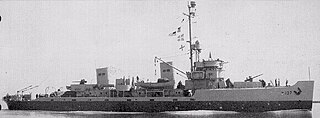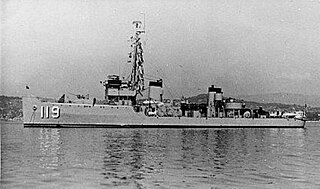
USS Rodman (DD-456/DMS-21), a Gleaves-class destroyer, is the first ship of the United States Navy to be named for Admiral Hugh Rodman.
USS Chickadee (AM-59) was an Auk-class minesweeper of the United States Navy, named after the Chickadee, a family of small passerine birds which appear in North America and Africa.

USS Parker (DD-604) was a Benson-class destroyer in the United States Navy during World War II. She was the second ship named for Foxhall A. Parker, Jr.

USS Andromeda (AKA-15) was an Andromeda-class attack cargo ship in service with the United States Navy from 1943 to 1956. She was scrapped in 1971.

USS Seer (AM-112/MSF-112/MMC-5) was an Auk-class minesweeper of the United States Navy that served during World War II and the Korean War, and was sold to Norway in 1962.
USS Symbol (AM-123) was an Auk-class minesweeper acquired by the United States Navy for the dangerous task of removing mines from minefields laid in the water to prevent ships from passing.

USS Tanager (AM-385) was an Auk-class minesweeper acquired by the United States Navy for the dangerous task of removing mines from minefields laid in the water to prevent ships from passing.
USS Pilot (AM-104) was a United States Navy Auk-class minesweeper that saw service in the Mediterranean and Pacific Theaters of Operations during World War II.

USS Prevail (AM-107) was an Auk-class minesweeper acquired by the United States Navy for the dangerous task of removing mines from minefields laid in the water to prevent ships from passing.

USS Staff (AM-114) was an Auk-class minesweeper acquired by the United States Navy for the dangerous task of removing mines from minefields laid in the water to prevent ships from passing.

USS Speed (AM-116) was an Auk-class minesweeper acquired by the United States Navy for the dangerous task of removing mines from minefields laid in the water to prevent ships from passing.

USS Steady (AM-118) was an Auk-class minesweeper acquired by the United States Navy for the dangerous task of removing mines from minefields laid in the water to prevent ships from passing.

USS Sustain (AM-119) was an Auk-class minesweeper acquired by the United States Navy for the dangerous task of removing mines from minefields laid in the water to prevent ships from passing.
USS Cardinal was a YMS-1-class minesweeper of the YMS-135 subclass built for the United States Navy during World War II. She was the third ship in the U.S. Navy to be named for the cardinal.
USS Pinnacle (AM-274) was an Admirable class minesweeper of the US Navy during World War II. She was laid down by the Gulf Shipbuilding Corp., Chickasaw, Alabama, 1 February 1943 launched 11 September 1943 sponsored by Mrs. Francis W. Osborn; and commissioned 24 May 1944.
USS Implicit (AM-246) was an Admirable-class minesweeper built for the U.S. Navy during World War II. She was built to clear minefields in offshore waters, and served the Navy in the North Atlantic Ocean and then in the Pacific Ocean. She finished the war with two battle stars to her credit.
USS Improve (AM-247) was an Admirable-class minesweeper built for the U.S. Navy during World War II. She was built to clear minefields in offshore waters, and served the Navy in the North Atlantic Ocean and then in the Pacific Ocean. Improve received two battle stars for World War II service.
USS Incredible (AM-249) was an Admirable-class minesweeper built for the U.S. Navy during World War II. She was built to clear minefields in offshore waters, and served the Navy in the North Atlantic Ocean and then in the Pacific Ocean. She returned home, finishing the war with two battle stars to her credit. When she was recalled for duty in the Korean War, she returned home again with four more battle stars.
USS Inflict (AM-251) was an Admirable-class minesweeper built for the U.S. Navy during World War II to clear offshore minefields and served the Navy in both the North Atlantic Ocean and the Pacific Ocean. At war's end, she returned home with three battle stars to her credit.
USS Mainstay (AM-261) was an Admirable-class minesweeper built for the U.S. Navy during World War II. She was built to clear minefields in offshore waters, and served the Navy in the Atlantic Ocean and the Pacific Ocean.









